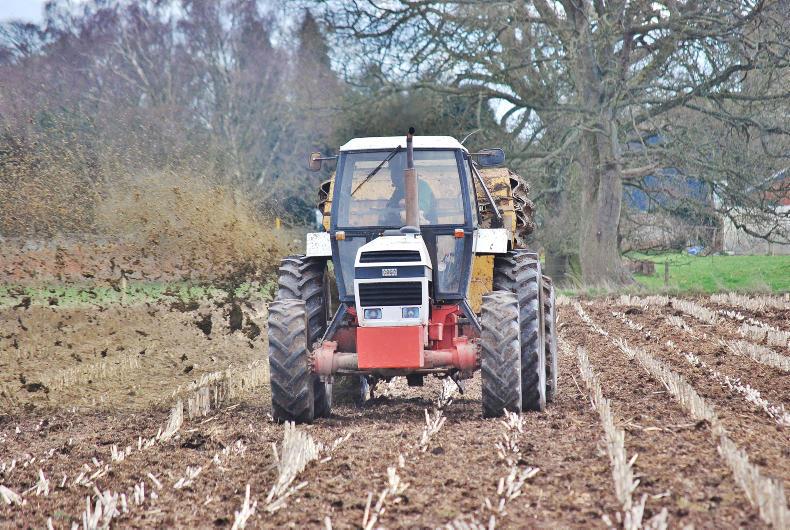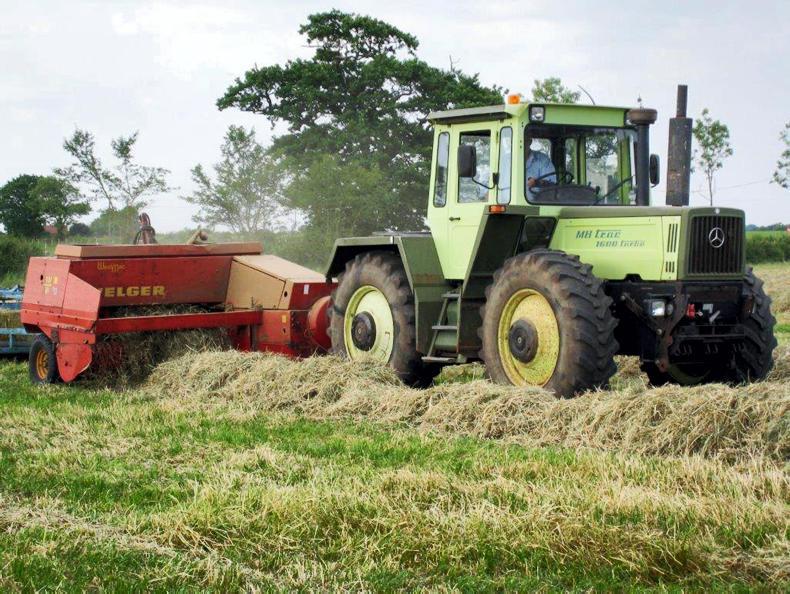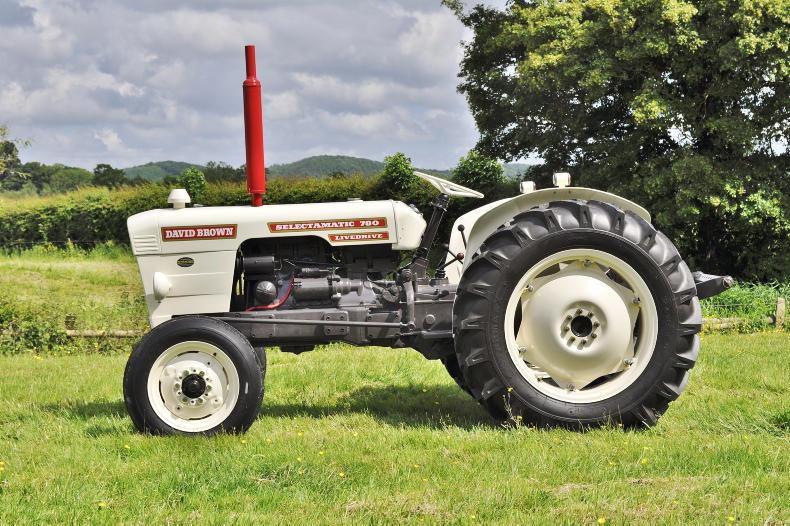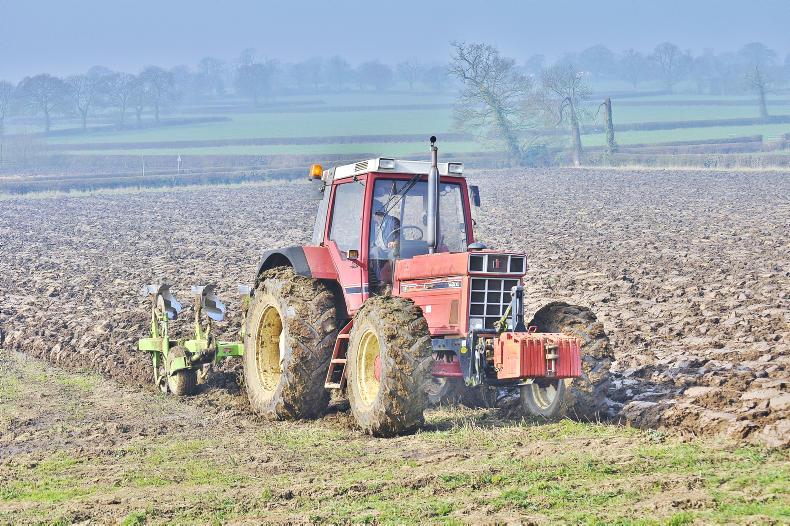It’s been almost three decades since a tractor rolled off the production line at the former David Brown tractor factory at Meltham Mills, in Yorkshire. Yet despite this long absence of new machines, there remains a contingency of diehard farmers throughout Ireland and the UK, for whom the David Brown tractor is still an integral part of their farming operation.
Five years ago it was reported that more than 10,000 David Browns were still registered in the UK alone. Even today, David Brown tractors are frequently favoured for loader work, powering a feed wagon or a straw chopper, and even for precision operations, such as seeding and planting.
Six Cylinders
 Farmer and contractor John Forman, who hails from Leicestershire, operates a fleet of David Brown tractors, including a DB 1210, and a DB 1412. While these older 1970s classics still play an important, albeit minor, role in his business, it is a pair of six cylinder David Brown models which John relies on for his contracting chores.
Farmer and contractor John Forman, who hails from Leicestershire, operates a fleet of David Brown tractors, including a DB 1210, and a DB 1412. While these older 1970s classics still play an important, albeit minor, role in his business, it is a pair of six cylinder David Brown models which John relies on for his contracting chores.
“I mainly do work for smaller, livestock farmers,” reveals John, who farms with his cousin Robert. “My work involves muck and slurry spreading, in addition to some ploughing, cultivating, power harrowing and hedge cutting.
“For the low volume of work I do, it doesn’t make economic sense for me to buy a new tractor. These may not be high-tech tractors, but they are very reliable and if something does go wrong they can be easily repaired. For me, that’s very important. They also have a frugal appetite for fuel. Modern 100hp tractors fitted with complex emission compliant engines, either use more diesel to burn off the exhaust pollutants, or require AdBlue, to produce exactly the same amount of power.”
The first of John’s six-pot classics, is a four-wheel drive DB 1690, equipped with factory-fitted Carraro front axle. This is John’s go to machine for ploughing, muck-spreading and using with his mid-mount McConnel hedge cutter.
“I bought the 1690 in 2008,” says John. “It was in rough condition, so I gave it a thorough overhaul and tidied her up. It has been a very good tractor.It pulls extremely well, and it handles a four-furrow plough beautifully. “
New 90 Series
David Brown enthusiasts, may recall the 90 Series was originally introduced in 1979. The new range featured completely new styling and a brand-new Q-cab, developed by the cab-manufacturer, Sekura.
The new range included five models, the largest of which was the 1690, which was the first six cylinder production model produced by David Brown since 1959.
The 1690, was initially powered by a naturally-aspirated version of David Brown’s 5,392cc six cylinder engine. Unfortunately, early versions didn’t quite produce the 103hp rating they’d been given, earning the tractor a reputation for being somewhat underpowered.

David Brown’s resolution, was to discontinue building the naturally-aspirated model, and introduce a turbocharged version, known as the 1690T. Launched in November 1982, just 501 of these turbo-tractors were produced before production stopped in October the following year, in time for the introduction of the 94 Series.
The 94 Series, infamously, was the first range of tractors produced by David Brown, which didn’t bare the company’s name. Branded simply as CASE, the largest model in the range was the 1694, which was equipped with the same turbocharged 108hp engine that David Brown had developed for the short-lived 1690T.
John Forman purchased his 1985 Case 1694 in 2001. The tractor was procured originally to power the farms Taarup forage harvester. In 2010 the Formans’ packed up milking, rendering the Taarup obsolete, but thankfully not the tractor.

Today, the 1694 is mainly used for power harrowing, cultivation work and haulage duties.
Magpie
Early 94 Series tractors, like John’s, initially featured white sheet metal, with a black chassis and orange wheels. Today, these tractors are frequently referred to as the ‘magpie’ 94 Series tractors. This livery scheme was superseded by a red and black paint scheme in 1986, following the 1985 merger between J.I Case /Tenneco, (which had owned David Brown since 1972), and International Harvester.
“The 1694 came from Kent,” explains John. “This really has been a cracking tractor. I have tweaked the fuel pump to give her a bit more grunt, and she really puts the power down well. I have found these six cylinder DB engines run better when they are working hard. Getting maximum power out of them requires a bit of smoke, and this engine pulls like a train.
“Another benefit with the 1694 is the tractor has the four-speed, semi-powershift David Brown Hydra-Shift gearbox. Four-wheel drive versions of the 1690 were only available with the three-range, 12-speed synchromesh transmission. Having the Hydra-Shift in the 1694, means I can make full use of the engine’s power, whether I am pulling a trailer up the road, or working in the field.”
According to John, despite having a reputation for being unreliable, the David Brown Hydra-Shift gearbox is virtually bulletproof, providing you use it correctly and regularly service the tractor.
 “These gearboxes will handle 150hp all day,” states John. “What lets them down, is that the gearbox uses the same oil as the hydraulic system. The back-end oil is constantly exposed to contamination, such as water and dirt, which enters through the spool valves when you’re tipping a trailer, or operating an implement which requires hydraulic power, such as a hedge cutter.
“These gearboxes will handle 150hp all day,” states John. “What lets them down, is that the gearbox uses the same oil as the hydraulic system. The back-end oil is constantly exposed to contamination, such as water and dirt, which enters through the spool valves when you’re tipping a trailer, or operating an implement which requires hydraulic power, such as a hedge cutter.
“The filtration system is very crude, so the oil must be regularly changed and the filter cleaned, to avoid damage to the gearbox components.
“When this gearbox came out in the 1212 tractor in 1972, it was years ahead of its time. The problem was that people didn’t know how to use them properly. You have to take your time with the Hydra-Shift. It’s not like a modern tractor. Use it properly and it will last forever.”
Workhorse
There’s one more workhorse in John Forman’s fleet, which is worthy of a mention.
This is a 1982 David Brown 1490, equipped with a 1.5t David Brown power loader, which he uses extensively for heavy loader work.

To offset the weight of the loader, and provide some much-needed ballast, the tractor carries a linkage-mounted 180 gallon sprayer tank filled with water, and has water-filled rear tyres.
“The combined value of my tractors, wouldn’t buy one modern tractor,” concludes John. “Yet together, they can do more work than a single new model could, with the benefit that they can be repaired in the farm workshop.
“These tractors, are perfectly suited to the kind of work I’m doing.”















SHARING OPTIONS